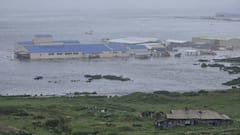EXPLAINED: Thousands Trapped At US Border As Title 42 Expires. What It Means And What Happens Next
Title 42 is a COVID-era provision which blocked most of the entry of most asylum-seekers from seeking legal entry into the United States.

Migrants rushed across Mexico's border hours before pandemic-related asylum restrictions were to expire on Thursday, fearing that new policies would make it far more difficult to gain entry into the United States. Hundreds of migrants have camped out at the border between Tijuana, Mexico, and San Diego. Title 42 is a COVID-era provision which blocked most of the entry of most asylum-seekers from seeking legal entry into the United States.
Some of the people have stayed at the borders for almost a week, hoping to turn themselves in to US Customs and Border Protection officials. However, they have been waiting in the open air with almost little to no food.
“We are very tired and hungry and I have been here for six days,” said Pham Thanh, 28, of Vietnam, told Reuters through the bollards of a 30-foot (10-metre) border barrier.
“President Biden, I’m asking to save us, please,” he said.
The estimated 400 migrants come from around the world. They are camped out in U.S. territory on a strip of land between two imposing border walls. As per the report, the southern wall is the official US-Mexican border, there are gaps and places from where it may be easier to climb. The other is the northern wall – 30 feet tall in many places and keeps them in.
Hashmutallah Habibi, 26, of Afghanistan, said he set out for the United States because “we cannot sit at home and wait for good things to happen in our country.”
But he never expected to get stuck at the foot of a dusty ravine, without a shower or clean clothes for six days, with a sick sister.
“I’m just hoping and praying that today they take us in because if they don't take us then my future and my family future is dark because we escaped from dark place," Habibi told Reuters.
While the Border Patrol didn’t explain how they were handling the migrants. The Border Patrol agents have organised them into groups, prioritising those who arrived first and women travelling with children, Reuters reported. Each of them has been given a colour-coded wristband - a sort of time stamp to mark their place in line. The highest priority group is occasionally called away for processing. Agents take pictures of their faces and passports.
Meanwhile, when the Border Patrol leave an area, aid workers distribute food and water through the bollards in the wall, again prioritising women with children. Beyond food and water, another lifeline volunteers provide is the charging of cell phones, so that migrants can communicate with loved ones back home.
Fabian Camilo Hernandez, 26, of Colombia, who is travelling with his wife and 22-month-old baby, said he would not have set out on the journey had he known what was to lie ahead.
“It’s hard to see him crying, not sleeping well,” Hernandez said. “I don’t want to think about what might happen. I just hope they let us in.”
What is Title 42?
Title 42, dates back to 1944 law known as the Public Health Act, which granted US authorities emergency powers to prevent the spread of diseases, according to the BBC. In March 2020, the Trump administration invoked the statute, citing the need to stop the spread of COVID-19 across its borders. Using this as a justification, US authorities were able to swiftly remove migrants crossing the border from Mexico - including asylum seekers.
Around 2.8 million people have been expelled under Title 42 since it was implemented, according to US Customs and Border Protection, BBC reported.
The end of Title 42
As per the Associated Press, after President Joe Biden took the office, he tried to keep Title 42 in place, then he tried to end its use in 2022. However, the Republicans sued, as they argued that the restrictions were necessary for border security, and the courts kept the rules in place.
However, the Biden administration announced in January that it was ending national COVID-19 emergencies officially on May 11 and so the border restrictions are now going away.
Biden has said the new changes are necessary, in part because Congress has passed no immigration reform in decades.
Starting at 11:59 p.m. EDT Thursday, the Title 42 restrictions were lifted.
Now, under the country’s international law, anyone who comes to the US can ask for asylum. People from all over the world come to the US-Mexico border to seek asylum in the US. They are screened to determine whether they have a credible fear of persecution in their homeland.
According to AP, their case then goes to the immigration court system to determine if they can stay in the US, but that process can take years. Usually they are released into the US to wait their cases out.
The Biden administration is now turning away anyone seeking asylum who didn’t first seek protection in a country they travelled through, or first applied online. This is a version of a Trump administration policy that was overturned by the courts, so it’s not clear whether this restriction will hold up, a lawsuit for the same is expected.
The US has said it will accept up to 30,000 per month from Venezuela, Haiti, Nicaragua and Cuba as long as they come by air, have a sponsor and apply online first. The government will also allow up to 100,000 people from Guatemala, El Salvador, and Honduras.
Whereas, Border officials will deport people otherwise, including turning 30,000 a month from Venezuela, Haiti, Nicaragua and Cuba back over the border to Mexico.
Other migrants may be allowed in, too, if they apply through the CBP One app. Right now, 740 people per day have been allowed in through the app and they’re increasing it up to 1,000 per day.
Related Video
Uttarakhand News: Winter Chill Grips North India; Kedarnath Dham Covered in Snow



































